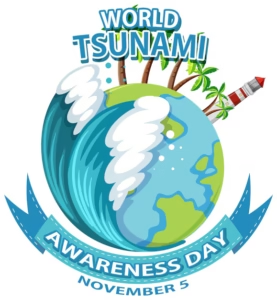 World Tsunami Awareness Day 2025: Raising Awareness and Preparedness for Tsunami Disasters
World Tsunami Awareness Day 2025: Raising Awareness and Preparedness for Tsunami Disasters
Introduction of World Tsunami Awareness Day
Every year, November 5th is observed as World Tsunami Awareness Day, a global initiative to raise awareness about the dangers of tsunamis and the importance of being prepared for these natural disasters. Tsunamis, massive sea waves triggered by underwater earthquakes, volcanic eruptions, or landslides, can cause widespread devastation, especially in coastal regions. This day highlights the need for early warning systems, disaster preparedness, and community education to reduce the loss of life and property in the event of a tsunami.
In 2025, World Tsunami Awareness Day will continue to educate people worldwide about the risks of tsunamis, encourage the implementation of preventive measures, and promote global collaboration for disaster risk reduction.
The Significance of World Tsunami Awareness Day
World Tsunami Awareness Day was established by the United Nations in 2015 following a proposal by Japan to mark the day when the Indian Ocean tsunami of 2004 devastated several coastal countries, resulting in over 230,000 deaths. The goal of the day is to foster a global conversation around tsunami preparedness, early warning systems, and disaster risk reduction efforts.
As tsunamis can strike with little or no warning, effective early warnings and community awareness are crucial to minimizing fatalities. The day serves as a reminder of the devastation caused by past tsunamis and urges governments, organizations, and individuals to take action to protect vulnerable coastal populations.
Tsunami Preparedness and Risk Reduction
1. Understanding Tsunamis:
Tsunamis are large, powerful waves caused by underwater earthquakes, volcanic eruptions, or landslides. These waves can travel at incredibly high speeds across oceans and strike coastal regions with little to no warning. The massive force of a tsunami can flood large areas, destroy infrastructure, and take lives. Knowing how tsunamis are generated and the potential risks in coastal regions is crucial for disaster preparedness.
2. Early Warning Systems:
An effective early warning system is one of the most important tools in tsunami preparedness. These systems detect seismic activity and oceanic changes that could lead to a tsunami, alerting affected regions so they can evacuate or take necessary precautions. Countries like Japan, Chile, and Indonesia have developed robust tsunami warning systems, saving countless lives during tsunami events.
The Indian Ocean Tsunami Warning System (IOTWS), established after the 2004 disaster, has significantly improved regional early warning efforts. Similarly, the Pacific Tsunami Warning Center (PTWC) monitors seismic activity and issues alerts to countries in the Pacific Basin.
3. Community Education:
One of the most effective ways to mitigate the risks of a tsunami is through community education. Local populations, especially in coastal areas, need to know what to do when a tsunami warning is issued. Tsunami drills, community workshops, and informational campaigns can help people understand the warning signs (such as unusual low tides) and the actions to take, such as moving to higher ground immediately.
Additionally, land-use planning and infrastructure development in coastal regions can reduce the impact of tsunamis by ensuring buildings are tsunami-resistant and that evacuation routes are clear and accessible.
How World Tsunami Awareness Day Helps
World Tsunami Awareness Day plays a crucial role in:
-
 Raising Global Awareness: The day highlights the importance of education and preparation for tsunami-prone areas worldwide. It encourages governments, organizations, and communities to prioritize disaster risk reduction measures and implement systems to protect populations.
Raising Global Awareness: The day highlights the importance of education and preparation for tsunami-prone areas worldwide. It encourages governments, organizations, and communities to prioritize disaster risk reduction measures and implement systems to protect populations. -
Promoting International Collaboration: Tsunamis are a global threat, and their impact often crosses national borders. On this day, countries come together to share knowledge, best practices, and resources to strengthen tsunami preparedness at a global level.
-
Highlighting Research and Innovation: Technological advancements in early warning systems, simulation models, and tsunami-resistant infrastructure are crucial in saving lives. World Tsunami Awareness Day encourages the global community to invest in and adopt the latest innovations to better prepare for future events.
How to Observe World Tsunami Awareness Day
-
Participate in Tsunami Drills: Many regions affected by tsunamis host community-wide tsunami drills on World Tsunami Awareness Day. These exercises help familiarize the public with evacuation routes and safety protocols in case of an emergency.
-
Learn About Tsunami Risks: Take time to educate yourself about tsunami risks in your area, especially if you live in a coastal zone. Research the early warning systems in place and familiarize yourself with local evacuation plans.
-
Support Organizations: There are numerous organizations focused on disaster risk reduction, climate change, and tsunami preparedness. Consider donating to or volunteering with organizations that work to build resilient communities and strengthen early warning systems.
-
Spread Awareness: Use social media platforms to share information about tsunami preparedness, early warning systems, and survival tips. Educating others can help save lives in the event of a tsunami.
The Future of Tsunami Risk Reduction
The continued development of global early warning systems, predictive modeling, and disaster management practices will play a crucial role in reducing the risk and impact of future tsunamis. With the increasing frequency of natural disasters and the threat posed by climate change, it’s important for nations to continue strengthening their resilience and collaborating to address global tsunami risks.
Conclusion
World Tsunami Awareness Day is a reminder of the devastating power of tsunamis and the importance of global cooperation in preparing for them. By investing in early warning systems, educating coastal communities, and supporting tsunami research, we can reduce the risk and impact of tsunamis on future generations.
Let us use this day to reflect on the lessons learned from past disasters and work together to ensure that tsunami preparedness is a priority for all nations. Together, we can help save lives and protect vulnerable populations from the dangers of tsunamis.
https://youtu.be/J3j9PJn_gVU?si=vtA7_l9sOTx3mRGJ
more information :-
